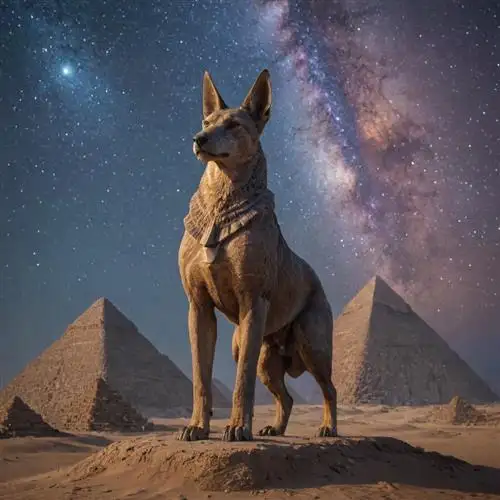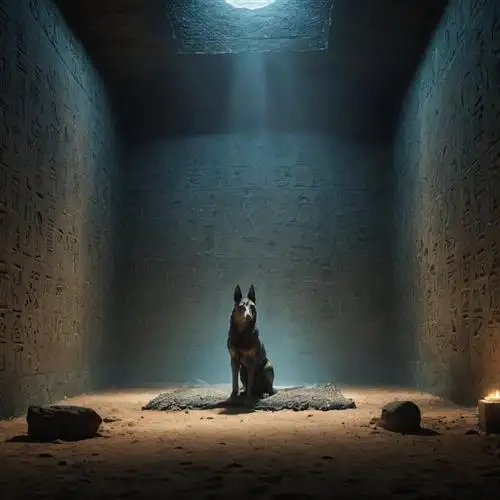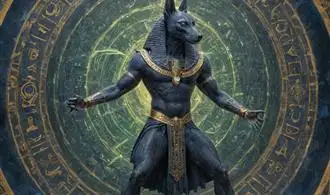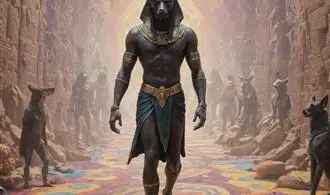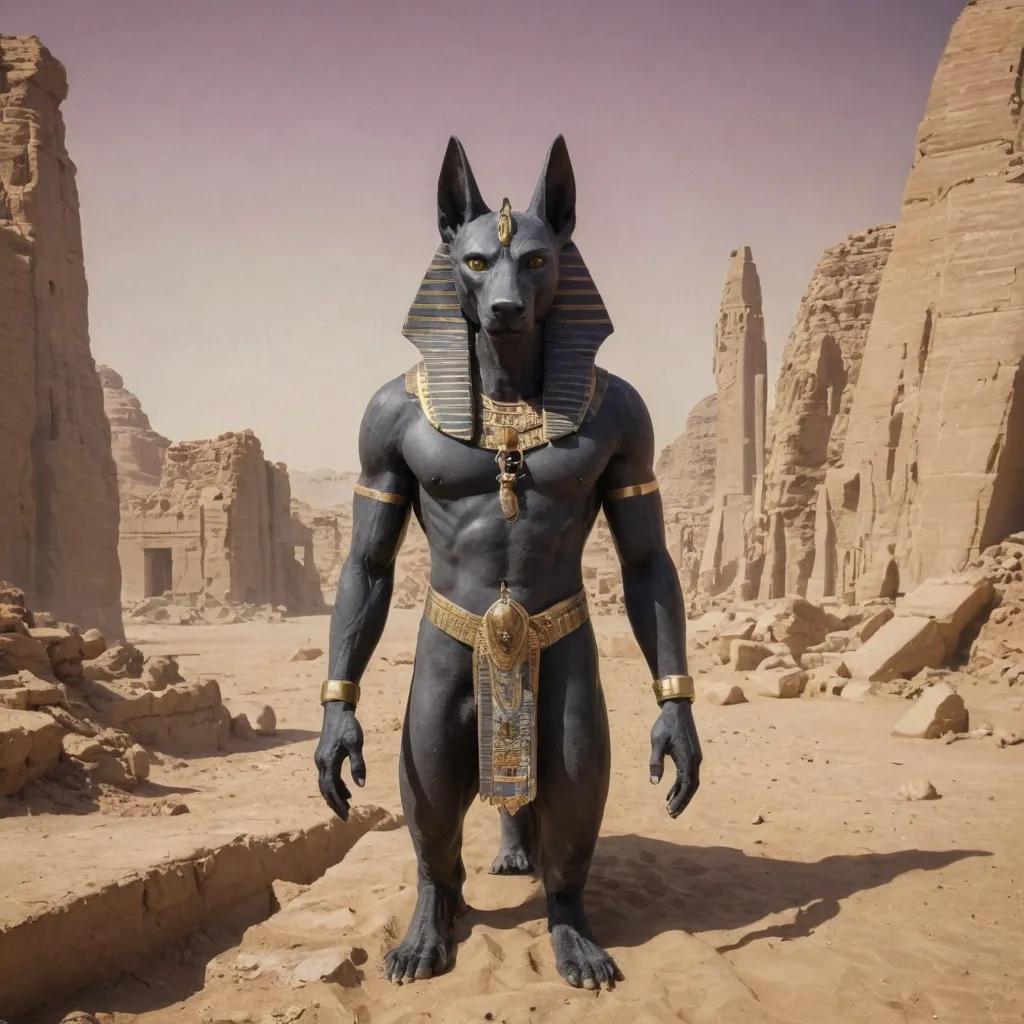
The Origin and Mythology of Anubis
Anubis, the ancient Egyptian deity associated with mummification and the afterlife, is a figure of immense significance in the pantheon of ancient Egyptian mythology. His origins can be traced back to the predynastic period, where he was initially worshipped as a jackal-headed god responsible for the protection and guidance of the dead. The mythology surrounding Anubis is rich and complex, offering insights into the ancient Egyptians' beliefs about the afterlife and the role of the divine in guiding the deceased on their journey to the next world.
In the earliest known depictions, Anubis is represented as a jackal-headed man, a reflection of the animal's association with the desert and its role as a scavenger of the dead. This symbolic connection between Anubis and the jackal was further solidified in the later periods of ancient Egyptian history, where the god was closely linked to the mummification process and the protection of the deceased.
According to Egyptian mythology, Anubis was the son of the goddess Nephthys and the god Set, although his parentage is sometimes disputed. Regardless of his exact lineage, Anubis was believed to be a central figure in the process of mummification, responsible for overseeing the embalming of the dead and ensuring the proper preparation of the body for the afterlife.
The role of Anubis in the afterlife was also of paramount importance. As the "Guardian of the Afterlife," Anubis was believed to be responsible for guiding the deceased through the various stages of the underworld, ensuring their safe passage to the realm of the dead. This included the crucial process of weighing the heart of the deceased against the feather of Ma'at, the goddess of truth and justice, to determine the individual's worthiness for eternal life.
The mythology of Anubis also intersects with other major deities in the Egyptian pantheon, such as Osiris, the god of the underworld, and Isis, the goddess of magic and healing. These interconnections further highlight the central role that Anubis played in the ancient Egyptian conception of the afterlife and the complex web of divine relationships that underpinned their religious beliefs.
Anubis Role as the Guardian of the Afterlife
Anubis, the jackal-headed god of ancient Egypt, is revered as the guardian of the afterlife. His role in the Egyptian pantheon is crucial, as he is responsible for guiding the deceased through the treacherous journey towards the afterlife and ensuring a smooth transition into the next world. To understand the depth and significance of Anubis's role, it is essential to explore the various aspects of his responsibilities as the guardian of the afterlife.
At the heart of Anubis's role is his responsibility for the mummification process. As the god of embalming, Anubis oversaw the intricate and sacred rituals of preparing the deceased for their journey to the afterlife. He was believed to possess the knowledge and expertise necessary to preserve the body, ensuring that the soul could reunite with the physical form after death. This connection between Anubis and the mummification process underscores his vital role in facilitating the transition from life to the afterlife.
Beyond the mummification process, Anubis also played a crucial role in the judgment of the dead. In the ancient Egyptian belief system, the deceased would stand before the gods, with Anubis weighing their heart against the feather of truth. This symbolic act, known as the "weighing of the heart," determined the fate of the soul. Anubis's presence during this pivotal moment was essential, as he ensured the fairness and integrity of the judgment process.
Furthermore, Anubis was believed to guide the deceased through the dangerous and uncertain journey to the afterlife. He was often depicted accompanying the soul, offering protection and guidance through the treacherous underworld. This role as a psychopomp, or guide of souls, was crucial in the ancient Egyptian belief system, as the afterlife was seen as a complex and perilous realm that required the assistance of a divine entity like Anubis.
Anubis's role as the guardian of the afterlife also extended to his responsibilities in the afterlife itself. He was believed to be the gatekeeper of the underworld, controlling access to the realm of the dead and ensuring the proper order and balance within this sacred domain. This authority over the afterlife reinforced Anubis's pivotal position in the Egyptian pantheon, as he was responsible for maintaining the delicate equilibrium between the world of the living and the world of the dead.
Anubis Symbolic Representation and Iconography
Anubis, the jackal-headed deity, holds a profound significance in ancient Egyptian mythology as the guardian of the afterlife. His symbolic representation and iconography offer deep insights into the role he played in the intricate tapestry of Egyptian spirituality and funerary practices.
Anubis's jackal-like appearance is a testament to his close association with the natural world and the afterlife. The jackal was a common sight in the deserts of ancient Egypt, often found near burial sites, scavenging for food. This connection with the liminal spaces between life and death led the Egyptians to revere Anubis as the protector of the dead, responsible for guiding the souls of the departed through the treacherous journey to the afterlife.
The iconography of Anubis is rich and multifaceted, with the deity often depicted in various poses and attributes. The most recognizable representation is that of a man with the head of a jackal, typically adorned with a distinctive headdress or crown. This iconic image serves as a visual reminder of Anubis's role as the gatekeeper to the afterlife, responsible for the mummification process and the weighing of the heart ceremony, where the deceased's soul was judged before being granted passage to the afterlife.
In addition to his jackal-headed form, Anubis is also sometimes depicted as a full jackal, standing upright or crouching, his watchful gaze ever-present over the deceased. This representation emphasizes Anubis's role as a protector and guardian, ever-vigilant in ensuring the safe passage of the soul to the next realm.
The symbolism of Anubis extends beyond his physical form, as his attributes and associated imagery hold deep significance. The Why the Symbolism of Anubis Matters More Than You Think article delves deeper into the rich symbolism and meaning behind Anubis's iconography, offering a more comprehensive understanding of his role in ancient Egyptian belief systems.
The Worship and Veneration of Anubis in Ancient Egypt
Anubis, the jackal-headed deity, was a central figure in the religious practices and beliefs of ancient Egypt. As the guardian of the afterlife, Anubis played a crucial role in the journey of the deceased, ensuring their successful transition to the hereafter. The worship and veneration of this ancient deity were deeply ingrained in the cultural fabric of ancient Egyptian society.
The worship of Anubis can be traced back to the early dynastic period of ancient Egypt, where he was revered as the god of embalming and the protector of the dead. This association stemmed from the jackal's natural tendency to linger near burial sites, leading the ancient Egyptians to believe that Anubis was guarding the tombs and the mummified remains of the deceased.
Anubis was responsible for the critical process of mummification, which was believed to be essential for the preservation of the soul and the body in the afterlife. The priests of Anubis would have been the ones responsible for overseeing this meticulous process, ensuring that the deceased were properly prepared for their journey to the afterlife.
In addition to his role in mummification, Anubis was also believed to guide the deceased through the complex and perilous journey to the afterlife. He was present during the judgment of the dead, where the heart of the deceased was weighed against the feather of truth. If the heart was found to be pure, the individual would be granted access to the afterlife, but if it was found wanting, they would be condemned to eternal torment.
The worship of Anubis was widespread throughout ancient Egypt, with numerous temples and shrines dedicated to the deity. These sacred spaces would have been the site of various rituals and ceremonies, where the faithful would come to pay their respects and seek the protection and guidance of Anubis.
The iconography of Anubis was also highly symbolic, with the jackal-headed deity often depicted holding a crook and a flail, symbols of kingship and authority. This representation reinforced Anubis' role as a powerful and influential deity, one who held sway over the afterlife and the fate of the deceased.
The Enduring Legacy and Modern Relevance of Anubis
The enduring legacy and modern relevance of Anubis, the ancient Egyptian god of the dead, is a testament to the profound and enduring impact of this iconic figure. As the guardian of the afterlife, Anubis played a crucial role in the Egyptian beliefs surrounding death and the journey to the afterlife, and his influence continues to captivate scholars, artists, and the public alike.
One of the most striking aspects of Anubis's legacy is his distinctive iconography. Depicted with the head of a jackal or wild dog, Anubis was believed to be the protector of the dead, guiding the deceased through the perilous journey to the afterlife. This powerful imagery has endured throughout the centuries, appearing in everything from ancient Egyptian tomb paintings to modern popular culture.
The significance of Anubis's role in the Egyptian afterlife cannot be overstated. As the god responsible for the embalming and mummification of the dead, Anubis was integral to the complex funerary rituals that were central to ancient Egyptian beliefs. He was present at the weighing of the heart ceremony, where the deceased's heart was weighed against the feather of truth to determine their worthiness for the afterlife.
Moreover, Anubis was believed to be the guardian of cemeteries and the protector of the dead. This role extended beyond the realm of the physical world, as Anubis was also thought to guide the souls of the deceased through the underworld, ensuring their safe passage to the afterlife.
The modern relevance of Anubis is equally compelling. As interest in ancient Egyptian culture and mythology has endured, Anubis has become a prominent figure in popular culture, appearing in films, television shows, literature, and various forms of art. This renewed fascination with Anubis speaks to the timeless appeal of his mythological significance and the enduring power of the ancient Egyptian belief system.
Additionally, Anubis has become a symbol of death, transition, and transformation, and his image is often used in modern occult and esoteric practices. This ongoing cultural relevance underscores the enduring impact of Anubis and the continued fascination with the mysteries of the ancient Egyptian afterlife.

